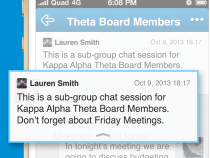
A new mobile chat application targeting college students, Quad, is working to move student organizations off of email and onto smartphones for managing their group communications. Despite the popularity of mobile messaging applications, like Whatsapp, Kik, GroupMe and dozens of others, few of these can support a large number of chat participants, often capping out at 50 users in a chat, if not fewer.
Even though the majority of college students today carry smartphones, and are increasingly turning to messaging apps for their personal communications, that 50-person limitation is a deal-breaker in terms of using most messaging clients within a bigger college group, like a fraternity, sorority, an academic group, sports team, or another sort of student organization.
That's the problem Quad set out to address starting this September, when the app first launched. Today, Quad has a presence on 2,500 of the 4,500 college campuses across the U.S., where on average, 10 to 15 percent of the students have begun to use the application.
Quad is the second app from Appsurdity, a company founded in late August 2012 by Mary Yang, formerly of SpeedDate, and Matthew Murphy, previously co-founder and CMO at Lemon, and who served as head of marketing at textbook rentals site, now academic hub, Chegg.com.
The company's first application, an “Instagram for voice” called Dubbler, has climbed to just over a million users, but the company's ten-person team has largely been spending their time on Quad in recent months.
Murphy says that the idea for Quad initially came from discussions with college interns working at Appsurdity.
“College groups are still very much the center point of the ecosystem on colleges campuses,” explains Murphy. And when he asked the interns how student groups communicate these days, they would sigh and admit that they still had to use email. The interns told him that mobile chat apps simply couldn't handle larger groups, much to Murphy's surprise.
“I started looking into it and found that GroupMe caps out at 50 people, Whatsapp caps out at 50 people, and iMessage caps out at 10 people,” he says, referencing a few of the high-profile apps within the mobile messaging landscape. But the problem wasn't one that was necessarily technical in nature, but rather one that was more of a usability challenge. That is, a group chat with hundreds of people participating would simply get too busy, too cluttered, and difficult to follow. Your phone would buzz non-stop.
A Mobile, Real-Time Forum
So in the latest version of Quad, out today, the company has introduced a user interface which is designed to make group communications in large groups better. To do so, the app takes the best of thread-based organization from online forums with the concept of topics and sub-topics, and has combined that with real-time mobile messaging.
In practice, the way this works is that each “quad” (group) in the app will break down into further “sub-quads” for the various topics that need to be covered, ranging from upcoming meeting announcements to discussions about recruitment efforts or anything else that interests the group in question.
“I haven't seen this done anywhere in mobile chat yet,” says Murphy.
In these sub-quads, users can share text, photos, emoji, contact cards, a location (such as, a meeting location), voice messages of up to 90 seconds, and more. There are also a few fun features, like a dice game and something called a “shake emoji” which is where you shake your phone to send an emoji which makes it look like the glass on your phone has broken. Why? Who knows? The students get bored in class, apparently.
While 90% of students in Quad's groups have an iPhone or Android smartphone, the app alos supports SMS for those who carry a non-supported phone, so as not to limit its ability to reach all the group's members.
In addition, today's release of Quad ups the number of users in a group to 500, from the 200 it allowed for following the app's soft launch earlier this fall.
Though Murphy declined to provide user numbers and actives, he would cite Penn State's adoption of Quad as a representative example. That college has over 400 groups on the app, with a combined 8,000 users out of a student population of 40,000. Now the team at Quad wants to further grow the app's footprint to reach 30 or even 50 percent of the student body on the campuses where it has traction, and expand to those where it doesn't yet have a presence.
Eventually, the plan is to generate revenue via in-app purchases for things like emoji packs and premium features.
Appsurdity is currently backed by some undisclosed angel funding, but may consider raising a round in the future to help it grow. And longer-term, Murphy says the team may consider bringing a version of Quad's feature set to other organizations, like businesses.
“It's definitely something we've been thinking about. Businesses would make perfect sense for it,” he says. But he said that change would come once the company tackles the college market first. “There are 21 million college students in the U.S. and then abroad, it expands exponentially…but we could evolve over time,” adds Murphy.

0 comments :
Post a Comment